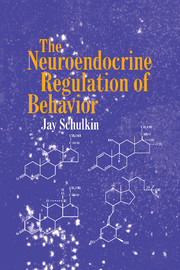Book contents
- Frontmatter
- Contents
- Acknowledgments
- Introduction
- 1 Hormones, Development, and Sexual Dimorphic Behaviors
- 2 Hormonal Regulation of Sodium and Water Ingestion
- 3 Hormonal Regulation of Food Selection
- 4 Hormones, Parental Care, and Attachment Behaviors
- 5 Hormonal Regulation of Fear and Stress
- 6 Hormones, Behavior, and Biological Clocks
- Conclusion
- References
- Name Index
- Subject Index
1 - Hormones, Development, and Sexual Dimorphic Behaviors
Published online by Cambridge University Press: 25 January 2011
- Frontmatter
- Contents
- Acknowledgments
- Introduction
- 1 Hormones, Development, and Sexual Dimorphic Behaviors
- 2 Hormonal Regulation of Sodium and Water Ingestion
- 3 Hormonal Regulation of Food Selection
- 4 Hormones, Parental Care, and Attachment Behaviors
- 5 Hormonal Regulation of Fear and Stress
- 6 Hormones, Behavior, and Biological Clocks
- Conclusion
- References
- Name Index
- Subject Index
Summary
Introduction
For many years, researchers have studied extensively how hormones regulate sexual dimorphic behavior in a range of species (e.g., Beach, 1948; Grunt and Young, 1952). It is well known that estrogen and progesterone stimulate female sexual behavior and that testosterone stimulates male sexual behavior, as reviewed by Goy and McEwen (1980).
Gonadal steroid hormones also regulate a number of other behaviors, such as the singing of birds, territorial behaviors, and spatial abilities in mammals (e.g., Wingfield, Whaing, and Marler, 1994). Although neither testosterone nor estrogen is considered the major hormone of aggression, estrogen can increase the likelihood of aggressiveness related to reproduction in a variety of species. Testosterone has been linked to aggression in males and females given suitable environmental contexts.
Sexual dimorphism in the brain and elsewhere has evolved through both natural selection and sexual selection (Darwin, 1958; Kelley, 1986). Darwin's emphasis on secondary sexual characteristics set the context in which we understand sexual dimorphism in behavioral endocrinology (Darwin, 1958): We look for functional reasons to explain why animals have the characteristics that they have. Although it is possible that not all sexual differences have functional consequences – it is easy to abuse adaptationists' arguments (Gould, 1977) – most no doubt tend to do so. The key to any organism's evolutionary success is sexual reproduction. Perhaps nowhere is this as clearly expressed as in sexually dimorphic characteristics. For example, it is well known that certain regions of the forebrain are sexually dimorphic (e.g., Raisman and Field, 1973; Gorski et al., 1978) and that these same brain regions underlie hormone-influenced behavioral responses.
- Type
- Chapter
- Information
- The Neuroendocrine Regulation of Behavior , pp. 17 - 52Publisher: Cambridge University PressPrint publication year: 1998



